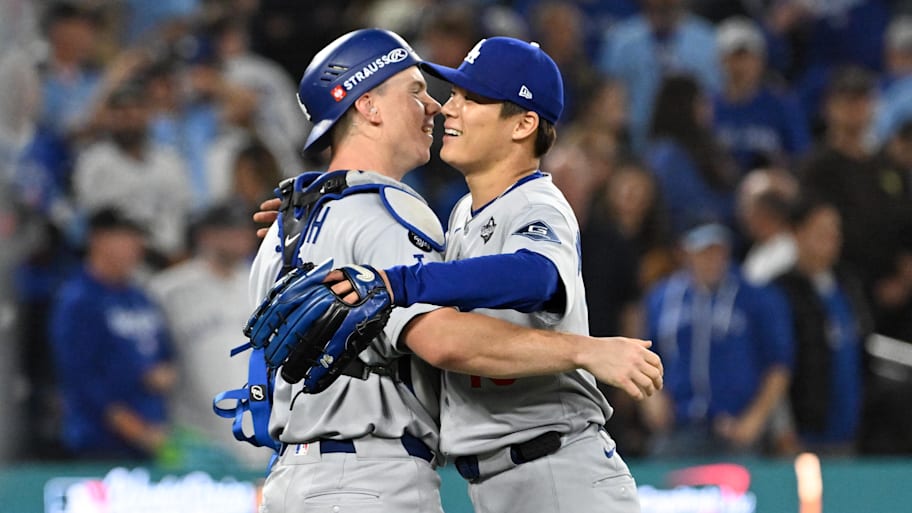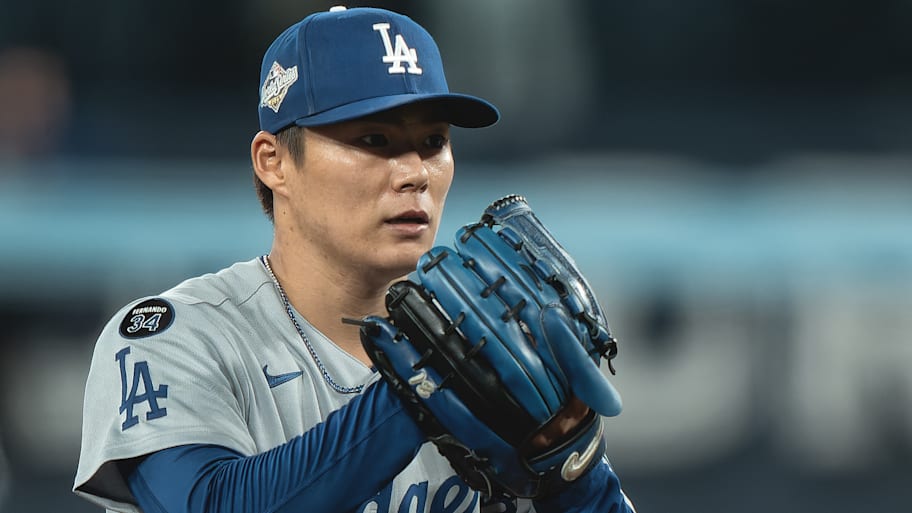TORONTO — The fingers of Dodgers catcher Will Smith played upon the keys of the PitchCom device on his right knee like those of a virtuoso pianist playing Johan Sebastian Bach. In and out, up and down, fast and slow, as if weaving multiple melodies within one work, Smith called one of the most beautiful World Series games ever composed because of how well the master on the mound followed his lead. Dodgers righthander Yoshinobu Yamamoto pitched the Brandenburg Concertos of the World Series oeuvre.
It was classical music on a ball field. Yamamoto threw 104 pitches at 19 different speeds with six different pitch types spaced apart as far as 24 mph. He didn’t just beat the hottest lineup of October; he also made the Toronto Blue Jays hitters appear overmatched in a 5–1 victory Saturday that evened the World Series at one throwback win apiece: an old-school contact-heavy win by Toronto in Game 1 and this magnum opus by Yamamoto in Game 2.
The World Series, now in its 121st iteration, has seen only eight other games pitched with this level of craftsmanship: a complete game win with no walks and as many as eight strikeouts. The only other Dodger to spin such a gem was Sandy Koufax in 1963 World Series Game 4. The other master composers were Madison Bumgarner in 2014, Cliff Lee in 2009, Phil Douglas in 1921 and dead ball era aces Rube Foster in 1915, Smoky Joe Wood in 1912, Eddie Plank in 1911 and Deacon Phillippe in 1903 in the first World Series game ever played.
Yamamoto has thrown back-to-back complete games (the first pitcher to do so since Curt Schilling 24 years ago) and this postseason is 3–1 with a 1.57 ERA with four walks contrasted against 26 strikeouts. He has been so good he now influences this series the way Bumgarner did in 2014, Orel Hershiser in 1988, Bob Gibson in 1967 and other aces of bygone eras whose next start loomed like the Sword of Damocles for the opponent. If there is a Game 6 back here, Yamamoto will get the ball. Toronto had better hope it is not an elimination game, which adds pressure to the next three games starting Monday in Los Angeles.
“He’s in a very good spot right now and he feels very good with everything that he is doing,” Dodgers pitching coach Mark Prior said. “That [process] has evolved over the year. It’s in a really good spot right now and hopefully we’re going to need it one more … maybe one more time.”
The Blue Jays cooled off in a hurry because they could not possibly cover everything Yamamoto threw at them: six pitches, all with impeccable command, between 74 and 98 mph. They could not rule out any pitch at any time. Yamamoto used all six pitches to get his 27 outs: 10 of them via his curveball, six with splitters, five with four-seamers, four with cutters, one with a slider and, as if showing off, one with a sinker not until his 26th out.
His game began double-single, putting runners on the corners with no outs and Rogers Centre quaking with anticipation of another fast-break, Showtime Lakers kind of night. Not so fast. Yamamoto leaned on his curveball and splitter for 14 of his next 17 pitches to get two strikeouts sandwiched around a pop-up to leave the runners right where they stood.
“You know, it’s funny,” said Galen Carr, Dodgers vice president of player personnel who made many a trip to Japan to scout Yamamoto before they signed him to the richest contract in pitcher-only history, $325 million over 12 years. “Because in Japan I think we would watch him and he’d get himself into a situation like that early on and then he’d just make pitches. He's a pitchmaker. His ability to mix and match, pitch to both sides of the plate, change speeds, planes and angles … it’s really unique.”
Said Prior, “And from then on, he was in pretty much control the whole time. It’s really his emotional heartbeat, you know, however you want to say. It just doesn’t seem phased, given the situation, given the magnitude of these games, given what we were coming off of last night …”
Dodgers Game 1 starter Blake Snell did not have his A stuff, giving up a career-high five hits on his changeup, spraying his fastball and working too hard to finish off hitters. The Blue Jays (who did not bat in the ninth in their home win) fouled off 39 pitches, the most over eight innings in a World Series game since pitch tracking began in 2008. Yamamoto had no such trouble. He had more whiffs (17) than foul balls allowed (16) while writing a prescription for the Dodgers for the rest of the series.

Yamamoto threw just 28% fastballs (sinkers and four-seamers), the lowest percentage by the Dodgers all year. The previous low was 32.4%, which happened in NLCS Game 2—another complete game win by Yamamoto. You are likely to see below-average fastball use from Los Angeles’ next two starters, Tyler Glasnow (56%) and Shohei Ohtani (46%).
“My pitching style is to just keep attacking the zone,” Yamamoto said. “So, every pitch I throw, I focus on getting to the strike zone. So, there’s not much adjustment in the game.”
He threw an astounding 70% strikes (73 of 105), another marker of his exquisite craftsmanship.
“If anyone else has any questions,” Carr said, “about why we gave this guy a contract that we did before he was pitching in the big leagues, I think he’s probably answered those questions.”
This is the series that put “world” into “World Series.” With the series back in Canada for the first time in 32 years, Game 2 featured players in the starting lineup from Japan, Canada, Mexico, Venezuela, the Dominican Republic and Cuba. The 5' 10" righthander from Japan proved on the biggest stage he is one of the best pitchers in the world.
“I think by the third [inning],” Prior said, “he just felt really good to where he had them caught in between. He could do what he wanted.”
It is an extraordinary admission by a pitching coach that his pitcher was so good he could choose pitches fairly at his whim. Only one other of the 175 starters who faced the Blue Jays this year rang up at least eight strikeouts with no walks against them: Zack Wheeler, who lasted only six innings in that start, not finishing his own start the way Yamamoto did.
After each half inning, Prior would sit down with Yamamoto and his interpreter on the dugout bench to review the next three or four hitters coming up the next inning for Toronto. Yamamoto also would crack open his black journal notebook, in which he has scribbled his own scouting report and assorted pitching notes. Not once in those discussions did Prior—or manager Dave Roberts, for that matter—inquire of Yamamoto of his energy level or remaining stamina, which is de rigueur in today’s bullpen-heavy game, when “third time around” is treated as frighteningly as the third rail of a subway line. No, it was plainly obvious that Yamamoto was plenty strong, even a whopping 202 1/3 innings into his year.
The pitching coach and manager had an easy call to keep running him back to the mound. The game belonged to Yamamoto and now to history. Meanwhile, the Sword of Damocles has been hung by its thin thread, for Yamamoto earned not only a place in World Series lore, but also until they may meet again inside the heads of Blue Jays hitters.
More MLB on Sports Illustrated
This article was originally published on www.si.com as Yoshinobu Yamamoto’s World Series Game 2 Win Was a Work of Art.
